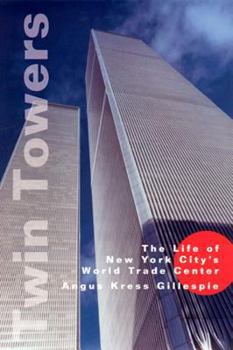Twin Towers: The Life of New York City's World Trade Center
Select Format
Select Condition 
Book Overview
This is a unique history that covers the complete life of the Twin Towers: the sky-high hopes during their planning and construction, the years during which they stood at the pinnacle of the Manhattan... This description may be from another edition of this product.
Format:Hardcover
Language:English
ISBN:0813527422
ISBN13:9780813527420
Release Date:November 1999
Publisher:Rutgers University Press
Length:263 Pages
Weight:1.35 lbs.
Dimensions:1.0" x 6.5" x 9.6"
Customer Reviews
5 ratings
History of the Twin Towers
Published by Thriftbooks.com User , 21 years ago
This book was written in 1999 as pressure was mounting for the Port Authority to turn the WTC over to a private agency. The book was reissued shortly after September 11 as the only scholarly history of the WTC. It's a fascinating study of political pressures and engineering feats. It's impossible to discuss the World Trade Center Towers without first understanding the New York/New Jersey Port Authority. Conceptually, it was unique when it was created in 1921. Authorities - quasi-governmental agencies that were authorized to build projects and then levy user fees to pay for them - had a long and well-established history in England. What made this new authority unique in 1921, when it was created to build the Holland Tunnel, was that it was granted a charter to build facilities, i.e., multiple projects. The idea for the WTC was conceived during a period of relentless optimism [Kenney] but "completed during a period of national gloom and retreat [Vietnam, 1970's, and Nixon's collapse.]" There were political aspects, aside from the desire to build the world's tallest building, and there was always the pressure from New Jersey to reduce bridge and tunnel tolls. A new project that would use these surplus funds would help to relieve that pressure. It was a project that was lauded by the critics at first, then reviled, only to be resurrected in the minds of New Yorkers, but never as an architectural triumph. It had the misfortune to fall between two architectural periods: International Style, with massive amounts of glass, and Postmodern, which represented a return to the more colorful and decorative building facades. Its Japanese architect, Minoru Yamasaki, used unique aluminum curtain walls that had been dyed to reflect light in unusual ways. The floor-to-ceiling windows were smaller, about the width of a large man, and set back from the curtain. This reduced heating and cooling expenses and eliminated the sense of vertigo that plagued other skyscrapers that had office space right up to the edge of the window, a more floor-efficient design. Yamasaki went through eighty iterations of the design, sometimes using three or four towers, but eventually settling on two. The spacing between them became critical because if placed too close together the winds sweeping down could create sympathetic vibrations in the buildings, destroying their integrity, i.e., a euphemism for causing them to fall down. The engineering was incredible, and the building could not have been built without technologies developed in other countries. The "Kangaroo" cranes that hoisted themselves up the elevator shafts were developed in Australia. Nothing like them was available in the United States. They were needed to raise the very heavy steel columns that were the load- bearing walls, another unique design feature of the buildings, and the floors. It was initially thought that only U.S. Steel or Bethlehem Steel, the two largest steel companies in the Un
The Complete History of a Tragedy that was bound to happen
Published by Thriftbooks.com User , 21 years ago
This book gives a inside view of the birth and the death of the World Trade Center. It shows how the rush to construct this late edifice led to many defects that were exposed on 9-11-01.
A MUST HAVE ITEM FOR YOUR BOOK COLLECTION...
Published by Thriftbooks.com User , 22 years ago
I found Mr Gillespie's Twin Towers very informative, comprehensive and well written. I especially enjoyed reading chapters 2 and 3, especially how he mentions how the Towers were both built from the ground up. I found chapter 4 to be very interesting, if not humorous-you'll find some interesting reading material about how the WTC gained some fame and acceptance, especially about the tight rope walker, the parachute jumper and the rock climber. Although, the diagrams made great pictorial examples, I believe actual photographs of the inside and outside would have made a great compliment to an excellent and well written piece of work!
An In-Depth Look At The Life Of A Beloved Icon
Published by Thriftbooks.com User , 22 years ago
I would reccomend this book to people who would like a detailed look at the Twin Towers. No full color photos here. They were destroyed because of it's affiliation with capitolism. Find out how they were constructed, the history of who constructed them[The Port Authority of NY and NJ] and why they were constructed. Why were they disliked by critics? You'll find out in this book. You will also find out the daily life of a person who onced worked there.
Twin Towers is a must read!
Published by Thriftbooks.com User , 24 years ago
As the Statue of Liberty is known around the world as the symbol of America and freedom, the Twin Towers are recognized around the world as the symbol of America and power. Angus Gillespie's "Twin Towers" sneaks the reader past security to see what it really took to create these modern day monuments to human greatness. The book also lets the reader peer through the eyes of the myriad of different people who work in the building, maintain the building, and even those who try to destroy the building. Simply fascinating!




